November itinerary in Japan Day 6 (Fukuoka Day 4)
(Saturday, November 20th)
Table of contents
1. Hakozaki Hachiman Shrine
On the last day (6th day) of my trip to Nagasaki and Fukuoka, I visited shrines and temples around Hakata. First I went to Hakozaki Hachiman Shrine. The public transportation I used is as follows.
Depart Ekimae 1-chome at 8:16, Nishitetsu bus 9 Hakozaki 3-chome line, arrive at Hakozaki at 8:31, fare Yen 240
Hakozaki Hachiman Shrine is about a 2-minute walk from the Hakozaki bus stop.
Hakozaki Hachiman Shrine is one of the three major Hachiman shrines in Japan, along with Usa Jingu (Oita Prefecture) and Iwashimizu Hachiman Shrine (Kyoto Prefecture). In addition, the Rōmon (tower gate) of Hakozaki Hachiman Shrine is said to be one of the three major tower gates in Japan, along with Kashima Jingu Shrine (Ibaraki Prefecture) and Aso Shrine (Kumamoto Prefecture).
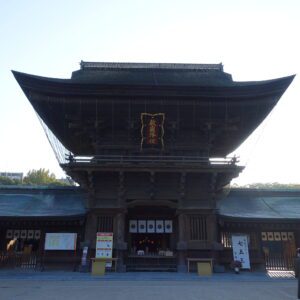
It is unknown when Hakozaki Hachiman Shrine was built, but it is said that Emperor Daigo wrote the letters of calligraphy “May the enemy nations prostrate themselves (in defeat)” in 921 and built a magnificent shrine here. The flat letters of “May the enemy nations prostrate themselves (in defeat)” on the Rōmon (tower gate) are a copy of the letters of calligraphy written by Emperor Kameyama (1274).
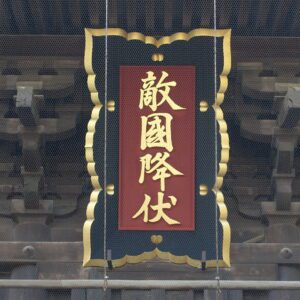
The Rōmon (tower gate) was built in 1594 by Takakage Kobayakawa. The Rōmon of Hakozaki Hachiman Shrine has the same atmosphere as the Rōmon of the Zen Buddhist temple, similar to the Rōmon of Kashiigu Shrine that I visited the day before. I don’t know if it was the influence of Emperor Kameyama, who protected Zen Buddhism, or the influence of Takakage Kobayakawa, a military commander. In 1591, Takakage Kobayakawa also rebuilt the main shrine of Dazaifu Tenmangu Shrine.
The main shrine of Hakozaki Hachiman Shrine has disappeared in flames due to the Mongol invasion in 1274. The characters written in the calligraphy of Emperor Kameyama mentioned above were paid for the reconstruction of the shrine. There were two Mongol invasions (1274, 1281) during the cloister rule of Emperor Kameyama. Emperor Kameyama, who overcame one of the greatest national difficulties in Japan’s history, has a huge statue of Emperor Kameyama (6.1m) enshrined in Hakozaki Hachimangu Shrine as a symbol of “breaking through the obstacles”.
Hakozaki Hachimangu Shrine was also worshiped by many military commanders such as Ashikaga Takauji and Toyotomi Hideyoshi as warding off evil and good luck. Hakozaki Hachimangu Shrine can be said to be the place where you can feel the Mongol invasion most.
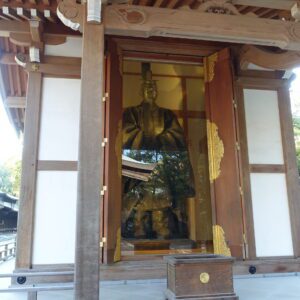
The main hall / worship hall, the tower gate, the Ichi-no Torii (the Hakozaki-style of torii), and the stone lanterns of Sen no Rikyu are national important cultural properties. Ichi-no Torii was built in 1609 by the feudal lord Kuroda Nagamasa. The main shrine, worship hall, and Sen no Rikyu stone lanterns can only be seen from the edge of the tower gate.
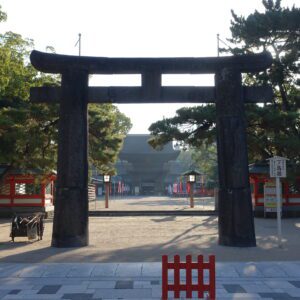
2. Tochoji Temple
I went to Tochoji Temple by bus from Hakozaki Hachimangu Shrine. The buses I used are as follows.
Depart Hakozaki 1-chome at 9:09, JR Kyushu Bus bound for Hakata Station, arrive at Gion at 9:22, fare Yen 230
Tochoji is the first temple in Japan built by Kobo Daishi (Kukai). In the Great Buddha Hall on the 2nd floor, there is the Great Buddha of Fukuoka (height 10.8m), which is one of the largest wooden statues in Japan. However, I could not see the proper figure of the Great Buddha during the large-scale repair. Also, photography is prohibited.
The principal image is the Senju Kannon Bodhisattva statue, which is a national important cultural property. It is only published on March 21st every year. However, you can see the eleven-faced Kannon Bodhisattva statue in the room next to the Great Buddha Hall. It was made during the Northern and Southern Dynasties (1337 – 1392).

Rokkakudo was built in 1842. It is a cultural property of Fukuoka City.
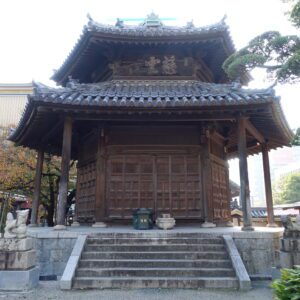
The five-storied pagoda was built in 2011. It is built by a traditional method that does not use nails.
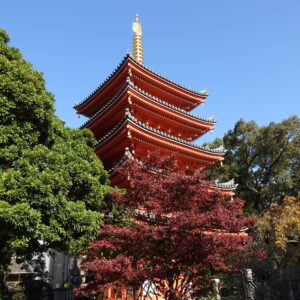
3. Kushida Shrine
I went to Kushida Shrine, which is about a 5-minute walk from Tochoji Temple. Hakata Gion Yamakasa (July) is dedicated. The decorative Yamakasa is permanently installed. Hakata Okunchi is held in October. The Hakata Dontaku group in May also has a tradition of departing from Kushida Shrine. In other words, Kushida Shrine is involved in many of the nationally famous festivals in Fukuoka.
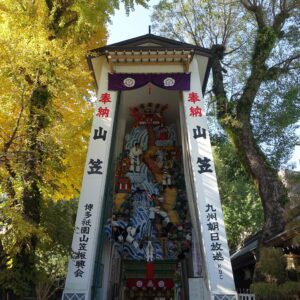
The Hakata Gion Yamakasa event is registered as a UNESCO Intangible Cultural Heritage, an important intangible cultural property of the country. However, strangely, Kushida Shrine does not have a nationally registered tangible cultural property.
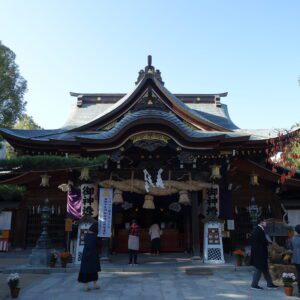
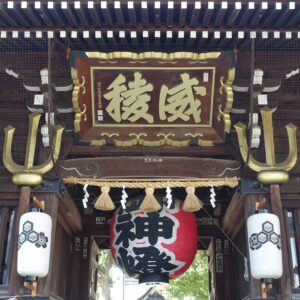
4. Nanzoin
After having lunch, I went to Nanzoin by train. The trains I used are as follows.
Depart Hakata Station at 11:30, JR Fukuhoku Yutaka Line Rapid bound for Nogata, arrive at Kidonanzoin-mae Station at 11:53, fare Yen 380
Nanzoin is the main temple of Sasaguri Shikoku Sacred Ground and is a special head temple of Koyasan Shingon sect. Sasaguri Shikoku is a sacred place in 88 places in Sasaguri-cho, Kasuya-gun, Fukuoka Prefecture. Sasaguri Town, where Nanzoin is located, is located in the lush green mountains, even though it is just over 20 minutes from Hakata Station.
The most famous statue in Nanzoin is the reclining Buddha. It is one of the largest bronze products in the world (total length 41m).
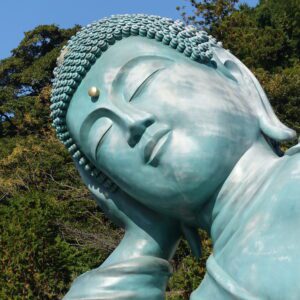
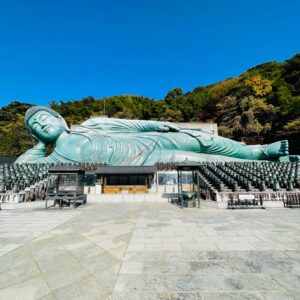
It was completed in May 1995. According to the Nanzoin website, in June of the same year, the chief priest of Nanzoin won the first prize of around Yen 130 million in the jumbo lottery, and it seems that the benefit of the Buddha’s reclining Buddha became a hot topic.
There are many Buddhist statues such as Fudo Myo and Bishamonten in the precincts of Nanzoin, and it is a fun precinct just to walk.
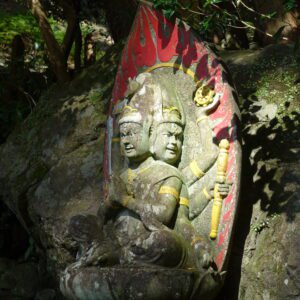
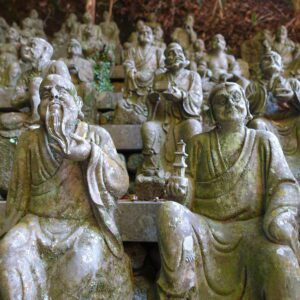
Please note that visiting Nanzoin is prohibited in clothes with a lot of exposed skin (hot pants, extreme miniskirts, camisoles, etc.). It’s winter now, so I think it’s okay, but be careful in the hot season. It seems that a cloth that can hide the exposure is rented at the shop in JR Kidonanzoin-mae station.
5. Hakata Sennen-no mon
I returned to Hakata Station from Nanzoin and visited shrines and temples in Hakata City. The trains I took to Hakata Station are as follows.
Depart Kidonanzoin-mae Station at 12:35, JR Fukuhoku Yutaka Line bound for Hakata, arrive at Hakata Station at 12:59, fare Yen 380
First, I went to Hakata Sennen-no mon, which is a little over 5 minutes on foot from Hakata Station. Hakata Sennen-no mon is the entrance to the temple and shrine town area of Hakata. After passing through the Hakata Sennen-no mon Gate, you will enter Jotenji-dori.

6. Jotenji Temple
Jotenji Temple was founded in 1242 by Shoichi Kokushi. It is a temple of the Tofukuji sect of the Rinzai sect, which is a sect of Zen sect. There is a magnificent stone garden in front of the main hall.
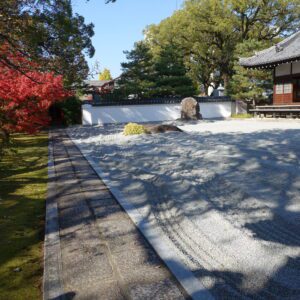
Jotenji Temple is also the birthplace of numerous events and goods such as Hakata Gion Yamakasa, Udon, Soba, Manju, and Hakata Ori. Hakata Gion Yamakasa is said to have originated from the fact that Shoichi Kokushi dispelled the illness in 1241 when the epidemic broke out in Hakata. Also, when Shoichi Kokushi returned from Song, he brought back the milling technique using a water wheel and spread the method of making udon and soba to Japan.
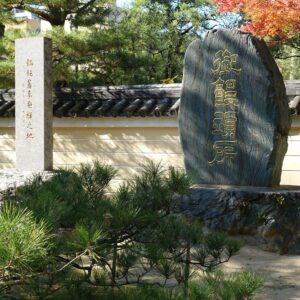
7. Myorakuji Temple
Myorakuji Temple, which is just a short walk from Jyotenji Temple, is a temple of the Rinzai sect Daitokuji sect, which is a sect of Zen sect. It was founded in 1316 by Gestudo Soki.
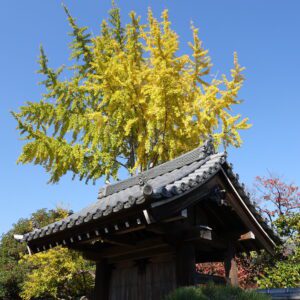
Originally, Myorakuji was located on the coast of Hakata Bay and played an important role in trade with the continent. Myorakuji is the birthplace of “Uiro”. A panacea made by a family of doctors, Chen Sokei, who had been exiled from the continent to Myorakuji, was served with a sweet made from rice flour. It seems that “Uiro” started when the Odawara Uiro family, who inherited the manufacturing method of this confectionery, put it on the market under the name “Uiro”. I’m not sure why “Uiro” became a specialty of Nagoya.
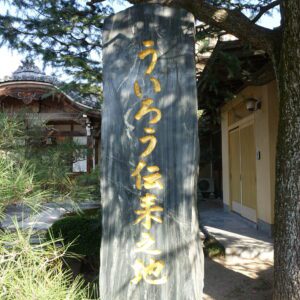
There was a magnificent Hakata-bei (Hakata wall) at Myorakuji. Hakata-bei began when Toyotomi Hideyoshi reconstructed the town of Hakata, which had been abandoned due to the war in the Warring States period, using burnt stones and roof tiles. I think it is also excellent in terms of design.
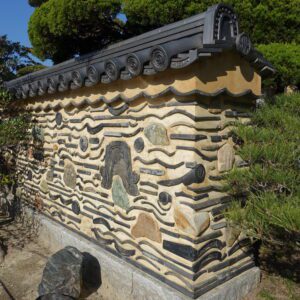
8. Shofukuji Temple
I went to Shofukuji Temple, which is just a short walk from Myorakuji Temple. Shofukuji is the first Zen temple in Japan (Rinzai sect Myoshinji school) founded by Yosai Zenji in 1195. The precincts are designated as a national historic site. The land of Shofukuji was donated by Minamoto no Yoritomo, the shogun of the Kamakura Shogunate.
There is a long Hakata-bei between the main gate and the Chokushi-mon gate. It was the most wonderful Hakata-bei I saw in Hakata.
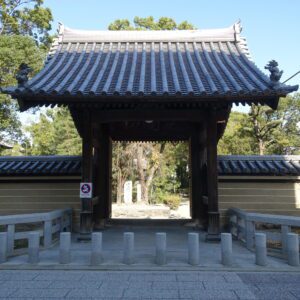
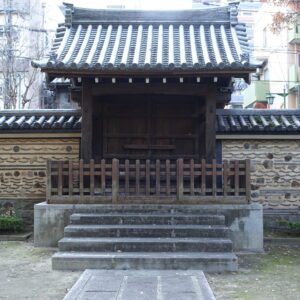
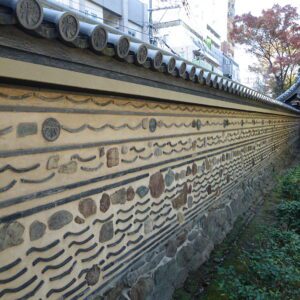
The gate was rebuilt in 1911. It is a magnificent mountain gate.
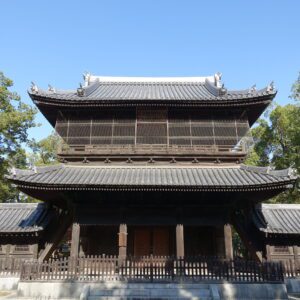
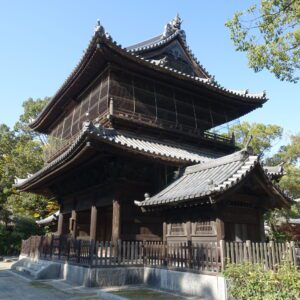
The Buddhist temple was expanded in 2014, so it is very beautiful. The past Buddha “Amitabha”, the modern Buddha “Shaka Nyorai”, and the future Buddha “Miroku Nyorai” have been newly built and enshrined. The three Buddhas are also very beautiful.
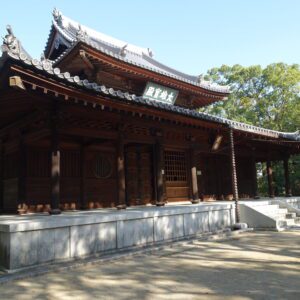
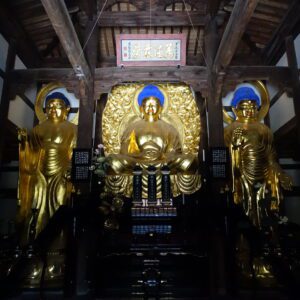
The precincts of Shofukuji Temple were so quiet that I couldn’t believe there was a temple in the middle of the big city of Hakata.
9. Rakusuien
I went to Rakusuien, which is about a 15-minute walk from Shofukuji Temple. Rakusuien is a Japanese garden with Chisen-Kaiyu-shiki-teien (go around the pond style garden). It is the site where Hakata merchant Zenuemon Shimozawa built the Sumiyoshi villa in 1906.
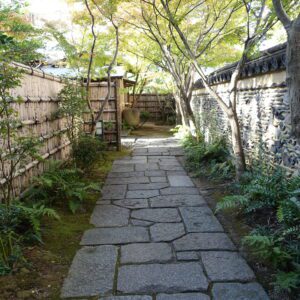
Rakusuien is, at best, a compact garden, or worse, a garden that is too small. It only takes about 3 minutes to go around the garden. It was Saturday, so it was crowded with many people.
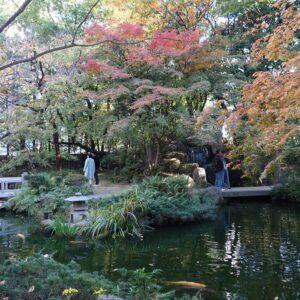
Admission: Adults Yen 100, Children Yen 50
10. Sumiyoshi Shrine
I went to Sumiyoshi Shrine, which is just a short walk from Rakusuien. It is a shrine that enshrines Sumiyoshi Sanjin, the guardian deity of voyage. The exact year of construction of Sumiyoshi Shrine is unknown, but it is said that the homepage of Sumiyoshi Shrine has a history of “more than 1800 years”. There is no doubt that it is an old shrine because there is a description of Sumiyoshi Shrine in “Shoku Nihongi (Chronicle of Japan Continued) ” (completed in 797). It is one of the “three major Sumiyoshi” along with Sumiyoshi Taisha in Osaka and Sumiyoshi Shrine in Shimonoseki.
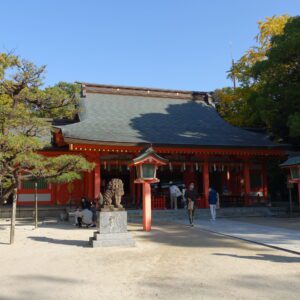
The main hall of shrine is a national important cultural property.
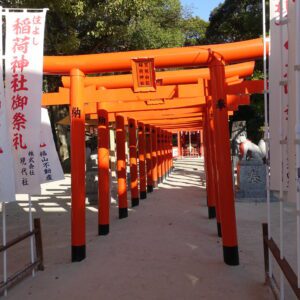
After visiting Sumiyoshi Shrine, I had an early dinner and then boarded an airplane and returned to Tokyo. I have been to Nagasaki and Fukuoka prefectures several times, but this time it was a trip with many new discoveries. In particular, the trip to Munakata City, Fukuoka Prefecture was very impressive.
Note: The departure / arrival times, fares, admission fees, meal fees, etc. of transportation listed in the text are as of the time of writing the BLOG. Please check for yourself when you go on a trip as it may change in the future.